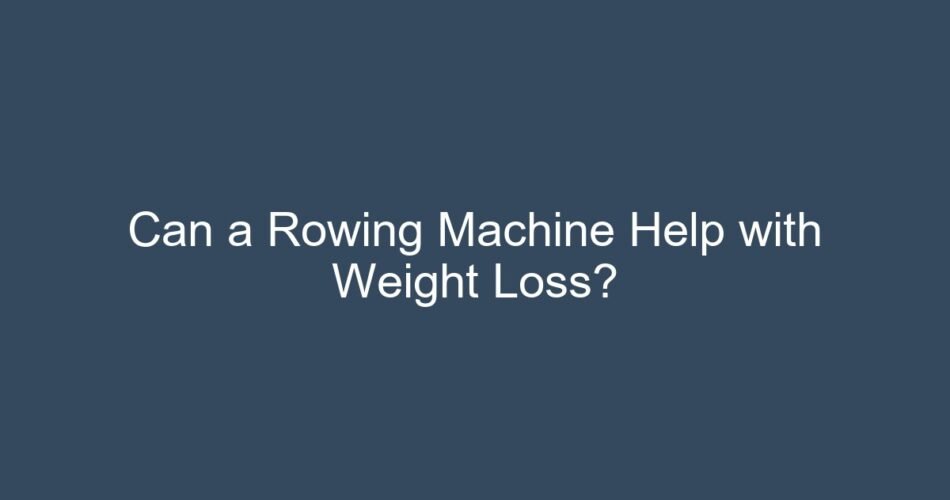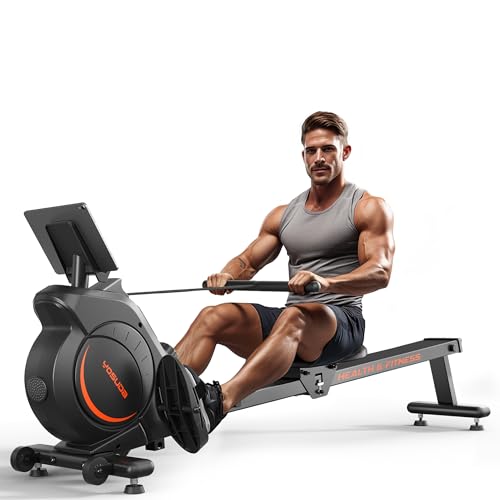Rowing is one of the most efficient tools for achieving a calorie deficit necessary for fat burning, making the answer to Can a Rowing Machine Help with Weight Loss? a resounding yes.
Yes, a rowing machine is highly effective for weight loss and overall body conditioning. It offers a unique combination of strength training and intense cardiovascular exercise, maximizing calorie burn in a single, low-impact movement. To understand precisely how rowing supports successful weight management, one must look at its total-body engagement and significant impact on metabolic rate.
The Science of Calorie Expenditure on the Ergometer
Weight loss fundamentally relies on achieving a consistent calorie deficit, meaning the body burns more energy than it consumes. The primary factor making the rowing ergometer an exceptional tool for this goal is its unparalleled muscle recruitment.
🛒 Recommended Product
Unlike machines that isolate specific body parts, rowing engages approximately 86% of the body’s skeletal musculature across nine major muscle groups. This extensive requirement for immediate energy consumption forces the cardiovascular system to work harder, leading to rapid and sustained calorie expenditure.
During a vigorous rowing session, the body follows a precise power sequence:
- Legs (60% of the power): Quadriceps, hamstrings, and glutes. These large muscles require vast amounts of energy to execute the powerful drive phase.
- Core and Back (20% of the power): Abdominals, spinal erectors, and lats stabilize the body and transfer force.
- Arms and Shoulders (20% of the power): Biceps, triceps, and deltoids finish the stroke by pulling the handle into the body.
Because so many major muscles are working simultaneously, the caloric output is extremely high. According to data modeled by sources like the American Council on Exercise, a person weighing 185 pounds can burn roughly 377 calories during 30 minutes of vigorous rowing. This rate often surpasses that of cycling and is competitive with high-speed running, but with the added benefit of minimal joint stress.
Furthermore, this high degree of muscle involvement promotes an elevated Excess Post-exercise Oxygen Consumption (EPOC), often called the afterburn effect. Because the muscles are heavily fatigued, the body continues to burn calories at an accelerated rate for several hours after the workout ends, further contributing to the total calorie deficit required for successful fat burning.
Rowing’s Dual-Action Advantage: Cardio and Strength
One of the greatest challenges in managing weight is balancing the need for fat loss (achieved through cardio) and maintaining or building muscle mass (achieved through resistance training). The rowing machine uniquely addresses both needs, creating a powerful synergy for body recomposition.
While many forms of cardio are highly effective at burning immediate calories, they can sometimes lead to muscle loss if not supplemented with dedicated strength training. Rowing provides a resistance element—the drag factor created by the flywheel or water tank—which serves as effective resistance training.
Key Benefits Beyond Calorie Burning:
- Muscle Preservation: By providing resistance, rowing helps prevent the muscle atrophy often associated with high volumes of steady-state cardio. Maintaining muscle mass is crucial because muscle tissue is metabolically expensive; the more muscle you have, the higher your resting metabolic rate (RMR) is, meaning you burn more calories even at rest.
- Cardiovascular Fitness: The intensity of rowing improves both aerobic capacity (endurance) and anaerobic capacity (short bursts of power). This improvement in cardiovascular fitness allows individuals to sustain higher intensity workouts over time, continually increasing calorie expenditure efficiency.
- Low Impact: Despite being a highly intense workout, rowing is non-weight bearing while seated. This makes it an ideal choice for individuals recovering from injury, those with joint pain, or those seeking a sustainable long-term exercise plan that won’t punish knees, hips, or ankles, unlike running.
Implementing a Rowing Routine for Sustainable Weight Management
While it is clear that rowing can help with weight loss, achieving results requires a structured approach focusing on consistency, intensity, and technique. Simply adding rowing to an already calorie-balanced diet is not enough; the routine must be optimized for maximum fat burning.
🛒 Recommended Product
Optimizing Intensity for Results
For weight loss, the most effective rowing routines typically utilize intensity variations, specifically incorporating High-Intensity Interval Training (HIIT).
| Training Protocol | Duration Example | Primary Benefit for Weight Loss |
|---|---|---|
| Steady-State Cardio (SS) | 45–60 minutes at a moderate pace (70% max heart rate) | Promotes long, sustained calorie burn; excellent for improving aerobic endurance. |
| High-Intensity Interval Training (HIIT) | Alternating 1 minute sprint / 2 minutes recovery, repeated 8 times | Maximizes EPOC (afterburn effect); rapidly boosts anaerobic capacity and metabolic rate in less time. |
| Pyramid Training | Gradually increasing distance/time per interval, then decreasing (e.g., 200m, 300m, 400m, 300m, 200m) | Combines high intensity with strategic rest, preventing burnout while accumulating volume. |
To ensure every stroke counts towards your weight loss goals, proper form—the “catch, drive, finish, recovery” sequence—is essential. Focusing on the powerful leg drive (60% of the movement) ensures maximum engagement of the body’s largest muscle groups, optimizing the calorie expenditure of the workout.
Rowing vs. Other Popular Cardio: A Comparison of Efficiency
When evaluating Can a Rowing Machine Help with Weight Loss, it is helpful to compare its efficiency against other common exercise modalities. While the exact calorie burn depends heavily on body weight, effort level, and duration, rowing consistently ranks among the top calorie-burning activities due to its full-body engagement.
The table below illustrates the approximate calorie burn for a 30-minute workout at a vigorous intensity, based on an average 155-pound individual:
| Activity | Estimated Calories Burned (30 minutes) | Primary Muscle Engagement | Impact Level |
|---|---|---|---|
| Rowing (Vigorous) | 377 | Full Body (86% recruitment) | Low |
| Running (6 mph/10 min mile) | 372 | Lower Body, Core | High |
| Elliptical Trainer | 335 | Lower Body, Arms (secondary) | Low |
| Stationary Cycling (Vigorous) | 358 | Lower Body | Low |
This comparison highlights that the rowing ergometer provides an intensity equal to or greater than running, yet maintains the joint protection offered by low-impact machines like the elliptical or stationary bike. This combination of efficiency and safety makes rowing a sustainable cornerstone for long-term weight management plans.
Long-Term Weight Management and the Rowing Lifestyle
Incorporating rowing into a holistic weight management plan is highly effective because it offers versatility. It can be used for long, steady-state sessions necessary for improving fat oxidation, or short, intense intervals that boost metabolism and EPOC.
The consistency that rowing allows, thanks to its low impact on joints, means that individuals are far less likely to be sidelined by injury. This uninterrupted routine is the single most important predictor of long-term weight loss success. By consistently creating the necessary calorie deficit and building muscle simultaneously, a rowing machine helps users achieve and sustain their ideal body composition.
🛒 Recommended Product
In conclusion, the answer to Can a Rowing Machine Help with Weight Loss is a definitive yes, as it provides a superior, low-impact, total-body workout that maximizes calorie expenditure and boosts resting metabolism for lasting results.
Scientific References & Research
The following peer-reviewed research papers provide additional scientific context:
-
GE Chapman (1997).
Making weight: Lightweight rowing, technologies of power, and technologies of the self
[External Link] -
A Ledvinkova (n.d.).
[HTML] Exercise Bike vs Rowing Machine: Which is Better for Weight Loss?
[External Link] -
H De las Casas et al. (2019).
Eccentric training with a powered rowing machine
[External Link]
Note: External research links are provided for educational purposes and do not necessarily represent endorsement.
Frequently Asked Questions About Can a Rowing Machine Help with Weight Loss?
Q. What is the optimal workout frequency and duration on a rowing machine to see significant weight loss results?
A. For noticeable weight loss, aim for 3-5 rowing sessions per week, with each session lasting between 20 to 45 minutes, depending on intensity. Consistency is key; combining steady-state cardio (longer, moderate intensity) with high-intensity interval training (HIIT) on the rower will maximize calorie burn and improve metabolic health efficiently. Ensure adequate rest and recovery days to prevent burnout and muscle fatigue.
Q. Does using a rowing machine primarily burn fat, or does it also contribute significantly to muscle gain and toning?
A. A rowing machine is excellent for both fat burning and muscle toning, as it works about 86% of the body’s muscles in a single stroke, including the legs, core, back, and arms. While the primary effect is aerobic fat loss, the resistance involved builds lean muscle mass, which further aids weight loss by increasing the basal metabolic rate (BMR). This combined effect leads to a leaner, more toned physique rather than just simple weight reduction.
Q. How important is proper rowing technique for maximizing the weight loss benefits and preventing injury?
A. Proper technique is crucial; an efficient rowing stroke ensures that the powerful leg drive—which constitutes about 60% of the movement—is fully utilized, thus maximizing caloric expenditure. Poor form, especially relying too heavily on the arms or back, reduces the intensity of the workout, limits calorie burn, and significantly increases the risk of injury, negating the low-impact advantage of the machine. Focus on the sequence: legs, core, arms; then arms, core, legs on the recovery.
Q. Can incorporating high-intensity interval training (HIIT) on a rowing machine accelerate weight loss more than steady-state rowing?
A. Yes, HIIT is highly effective on a rowing machine because it alternates short bursts of maximum effort with brief recovery periods, leading to a phenomenon known as the “afterburn effect” (EPOC). This method significantly elevates the heart rate and metabolism, causing the body to continue burning calories at an increased rate for hours after the workout is completed, dramatically accelerating fat loss compared to consistent moderate effort.
Q. Besides the exercise itself, what role does diet and nutrition play when using a rowing machine specifically for weight loss goals?
A. Diet and nutrition are paramount, as weight loss fundamentally requires consuming fewer calories than are expended, even with intense rowing. While rowing increases energy expenditure significantly, failing to maintain a caloric deficit and consume adequate protein and healthy fats will undermine even the most rigorous workout schedule. Think of rowing as the catalyst that makes dietary changes more impactful and sustainable.
Q. Are there specific resistance or damper settings on a rowing machine that are better suited for optimal weight loss results?
A. The damper setting controls the feel of the stroke (how much air gets into the flywheel) but does not equate directly to resistance or intensity; rather, weight loss is maximized by maintaining a high stroke rate and intensity regardless of the damper setting. Generally, a mid-range damper setting (between 3 and 5) is recommended for most users to achieve an effective, intense workout without undue strain, allowing for the highest sustained effort and calorie burn.
Related Articles
What Is the Best Workout Machine for Weight Loss?
Trying to determine what is the best workout machine for weight loss? While several options deliver results, the rowing machine often provides the max…
Do Vibrating Weight Loss Machines Work?
Do vibrating weight loss machines work? The scientific data is clear: while these vibration therapy plates offer proven benefits like muscle stimulati…
Treadmill Workouts for Buttocks: Sculpt and Tone Your Glutes
Getting fit and shaping your buttocks can be challenging. Treadmill workouts might be the solution you need. Treadmill workouts are not just for cardi…
When you purchase a product through Amazon links on EllipticalKing.com, we may earn a small commission at no extra cost to you. This helps support the site and keep our content free.




